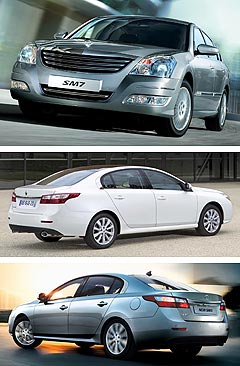Seoul show: Samsung teases sleek new SM7 sedan
BY HAITHAM RAZAGUI | 28th Mar 2011

The sketch shows a sleeker vision for the model – and indeed the brand’s future – replacing the chunky, incongruous Maxima-derived lines of the current version with what appears to be a steeply raked windscreen flowing into a low-slung coupe-like roofline.
A large Audi-style grille and elongated, upswept headlights that lead to a pronounced shoulder line point to a stylish new direction for the French-owned South Korean carmaker.
Compared with Samsung’s current range of conservatively styled offerings, the SM7 replacement’s new look comes at a time when the brand must raise its game in the design stakes.
Local rivals Kia and Hyundai are now turning out stylish and attractive cars, GM Korea (nee Daewoo) has finally discovered styling and even SsangYong has made progress with its Italian-designed Korando SUV.

Little is known about the SM7’s replacement as Renault-Samsung is yet to release any official details, but reports suggest it will ride on an elongated version of the platform that underpins the Samsung SM5 and closely-related Renault Latitude sedans.
Renault Australia imports rebadged Samsungs in the form of its second best-seller, the Nissan-developed Koleos SUV, and the Fluence small sedan.
In South Korea, the two Samsung-badged cars have slightly different styling and are designated QM5 and SM3 respectively.
The next Samsung-built car to make it Down Under will be the Renault Latitude, which is based on the SM5 sedan and forms a replacement for the slow-selling Laguna.
Renault Australia previewed the Latitude at the 2010 Sydney motor show and has scheduled it for local release next month, priced from below $40,000 and powered by a choice of petrol and diesel engines.
Renault-Samsung is South Korea’s fourth-largest vehicle manufacturer. Based in Busan, 400 kilometres south-east of Seoul, its manufacturing facility employs more than 3000 people and has a production capacity of 300,000 vehicles per year.
Renault has sold 317 cars in Australia so far this year, up five per cent on 2010. With 61 Koleos SUVs and 38 Fluence sedans finding homes, just under a third of Renault’s Australian sales are South Korean imports.